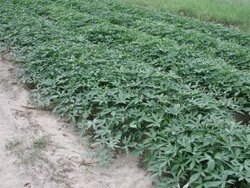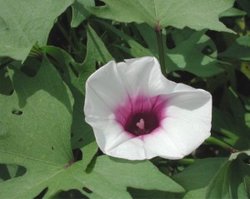Sweet potato
|
|
| Sweet Potato | ||||||||||||||
|---|---|---|---|---|---|---|---|---|---|---|---|---|---|---|
 | ||||||||||||||
| Scientific classification | ||||||||||||||
|
The sweet potato (Ipomoea batatas) is a crop plant whose large, starchy, sweet-tasting tuberous roots are an important root vegetable. The young leaves and shoots are sometimes eaten as greens. The sweet potato is only distantly related to the potato (Solanum tuberosum). Although the sweet potato is sometimes known as yam in the United States, it is unrelated to the botanical yam.
The genus Ipomoea that contains the sweet potato also includes several garden flowers called morning glories, though that term is not usually extended to Ipomoea batatas. Some variants of Ipomoea batatas are grown as houseplants.
Sweet potatoes are native to Central America or South America and were domesticated there at least 5000 years ago. They were then spread throughout the tropical Americas and the Caribbean. They were also known in pre-Columbian times in Polynesia. How exactly they arrived there is the subject of a fierce debate which involves archaeological, linguistic and genetic evidence.
Description
The edible tuberous root is long and tapered, with a smooth skin. Its flesh ranges from white to yellow, orange, or purple. All varieties are more-or-less sweet-flavored.
Under optimal conditions of 85–90% relative humidity at 13–16�C (55–61�F), sweet potatoes can keep for six months. Colder temperatures injure the roots.
Sweet potatoes are rich in dietary fiber, vitamin A, vitamin C, and vitamin B6. In some tropical areas, they are a staple food crop. The storage roots, leaves, and shoots are all edible. The storage roots are most frequently boiled, fried, or baked. They can also be processed to make starch and a partial flour substitute. All parts of the plant are used for animal feed. Industrial uses include the production of starch and industrial alcohol.
Cultivation
The plant is a perennial vine that does not tolerate frost. It grows best at an average temperature of 24�C. Depending on the variety and conditions, tuberous roots mature in 2–9 months. With care, early-maturing varieties can be grown as an annual summer crop in temperate areas, such as the northern USA. Sweet potatoes rarely flower when the daylight is longer than 11 hours, as is normal outside of the tropics. They are mostly propagated by stem or root cuttings or by adventitious roots called slips that grow out from the tuberous roots during storage. True seeds are used for breeding only.
According to FAO, 98% of world sweet potato production occurred in developing coutries in 1994. China alone made up 84% of the harvest, producing about 105,000 tonnes (115,743 short tons) on 65 km� (25 mi�).
North Carolina is single largest producer of sweet potatoes in the US. However, when added to the production from Louisana, Alabama, Mississippi, Arkansas,Texas, and California, there is enough volume to supply the US, Canada, and European markets.
Yams vs Sweet Potatoes
The moist-fleshed, orange varieties of sweet potato are frequently referred to as "yams" ( originally expressed as "yum" by the Native American Indian when they were first introduced to them by the Spaniards). Another explaination is that confusion first started with African slaves brought over from the west coast of Africa. Africans brought to America took to calling American sweet potatoes Nyamis (a Senegalese word meaning "to eat"), which referred to the plant grown in Africa, but not seen in North America. However, the true yam which is grown in South America can grow up to 2 m (6 ft) in length (somtimes with knuckle like ends), has a scaley-like skin, has a pinkish white center and has a thick almost oily feel to the tongue.
After the confusion started over one hundred years ago, many farmers and stores began marketing American-grown sweet potatoes as yams; the name stuck. In more recent times there has been an effort to stop the use of "yam" for sweet potatoes but this has only been partially successful. USDA branding regulations require the word "Yam" to be accompanied by the words "Sweet Potato" when referring to these moister sweet potatoes.
The term "candied yams" is used to refer to the sweet side dish consisting mainly of heavily sugared sweet potatoes often served on American Thanksgiving. It is a very characteristic dish and represents traditional American cooking and indigenous food.


